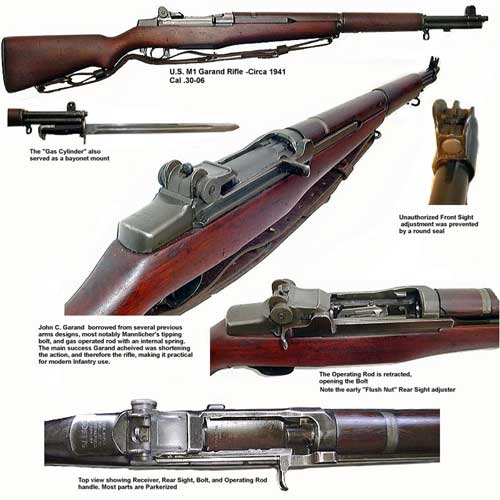

The rear sight on the M1 rifle is quite different than the typical tangent used on most other models of the time. 4, encouraging actual aiming.” While the M1903 Springfield, seen here, was a sturdy and accurate rifle, it offered no real advantage over a German Kar 98k or Japanese Arisaka. He commented, “Best sights ever issued on a combat rifle.” Patrick Sweeney agreed and added, “It had far better sights than any other rifle until the British Lee Enfield No. Firearms News Gunsmithing Editor, Gus Norcross, is an old NGMTU armorer who has rebuilt many a Garand and shot the National Match model in competition. Going in no particular order, let’s start with the sights. Moving on from the obvious, let’s take a look at some of the other important features which sets the M1 rifle apart from the crowd. Most importantly, it earned the trust of those who carried it into combat. While not perfect, the M1 rifle was considered very reliable at the time. The M1 Garand on the other hand earned a reputation for both reliability and robustness. They all invariably fell short in the mud, dirt and abuse experienced in the field. Many semi-automatic designs had come before it, such as the French 8mm RSC M1917 fielded during World War I. Overall, the Garand is a solid, stable, robust and accurate platform.” A key element to the M1 Garand’s success isn’t just the fact that it was a semi-automatic rifle, but rather that it actually worked when the chips were down. Being gas-operated, it has a relatively smooth recoil impulse, as opposed to the M1903. Michelle Hamilton added, “I think one of the great features of the M1 Garand is the fact that it is a gas-operated, semi-auto, giving a distinct advantage over the Kar 98k and Arisakas. The M1 Garand replaced a bolt-action at a time when no one else but the Soviet Union with their SVT-38/40 was fielding semi-autos, and the SVT-40 ultimately failed.” Everything else is comparatively irrelevant, at least when compared to the other rifles used by our enemies. He was a bit animated as he stated, "Being a ‘semi-auto’ general issue arm is as important as every other reason combined. Everyone I spoke with mentioned this, although James Tarr was the most vocal. Now obviously being a semi-automatic design in a world awash with bolt-guns gave it an advantage. In the case of the M1 rifle, it was the right rifle at the right time. It is never one feature which makes a rifle great, but rather a combination of both features and timing. So, WHAT made the M1 Garand a great rifle? What set it apart from all the other fighting rifles available in 1940 and fielded during World War II? Why did GIs like and respect this design to such a high degree? Rather than simply share my research, experience and opinion, I decided to pose this question to colleagues and share their answers as well. It wasn’t a single feature which made the M1 Garand a great fighting rifle, it was a combination of many which allowed it to excel on the battlefield. While a bit beefier in the hands compared to the M1903 Springfield rifle it replaced, the M1 feels and handles like a traditional combat rifle of the time. It accepts a bayonet and grenade launcher, has bottom mounted sling swivels and a trap in the butt for a cleaning kit.


30-’06 Government, it has a 24-inch barrel, overall length of 43.5 inches and weighs in at 9.5 pounds. The result of his work was a robust semi-automatic rifle which features a long-stroke gas piston, dual-lug rotating bolt, internal eight-round magazine, fully adjustable rear aperture sight, protected front sight and a wood stock. It was patented in 1932, adopted in 1936 and placed into mass production in 1940. His life between the two world wars was devoted to designing, and then further refining what became the “Semiautomatic, Caliber. Garand worked as an engineer at Springfield Armory tasked with developing a self-loading rifle for the US Army. He worked on small arms designs during World War I, went to work for the US government arsenal Springfield Armory in November 1919, and became a US citizen in 1920. The rifle was designed by John (Jean) Cantius Garand (– Feb 16, 1974) who was born in St.


 0 kommentar(er)
0 kommentar(er)
